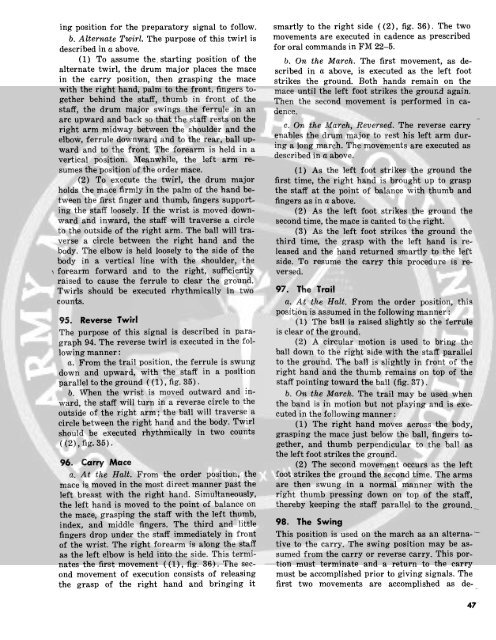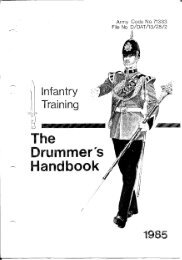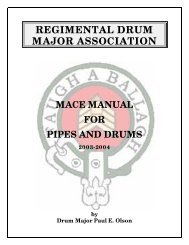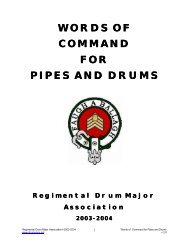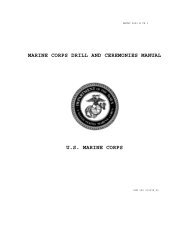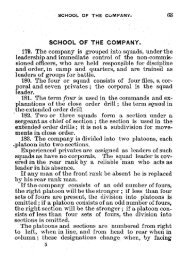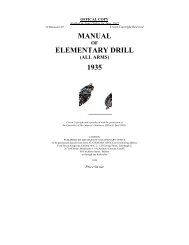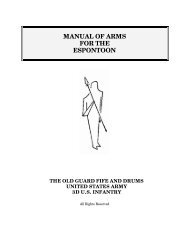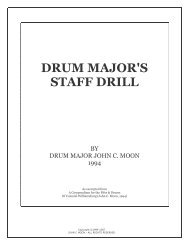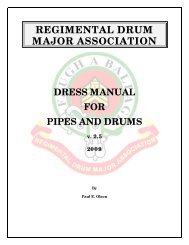The Military Band - Regimental Drum Major Association
The Military Band - Regimental Drum Major Association
The Military Band - Regimental Drum Major Association
Create successful ePaper yourself
Turn your PDF publications into a flip-book with our unique Google optimized e-Paper software.
ing position for the preparatory signal to follow. smartly to the right side ((2), fig. 36). <strong>The</strong> two<br />
b. Alternate Twirl. <strong>The</strong> purpose of this twirl is movements are executed in cadence as prescribed<br />
described in a above. for oral commands in FM 22-5.<br />
(1) To assume the, starting position of the b. On the March. <strong>The</strong> first movement, as dealternate<br />
twirl, the drum major places the mace scribed in a above, is executed as the left foot<br />
in the carry position, then grasping the mace strikes the ground. Both hands remain on the<br />
with the right hand, palm to the front, fingers to- mace until the left foot strikes the ground again.<br />
gether behind the staff, thumb in front of the <strong>The</strong>n the second movement is performed in castaff,<br />
the drum major swings the ferrule in an dence.<br />
arc upward and back so that the staff rests on the<br />
right arm midway between the shoulder and the c. On the March, Reversed. <strong>The</strong> reverse carry<br />
elbow, ferrule downward and to the rear, ball up- enables the drum major to rest his left arm durward<br />
and to the front. <strong>The</strong> forearm is held in a ing a long march. <strong>The</strong> movements are executed as<br />
vertical position. Meanwhile, the left arm resumes<br />
the position of the order mace. (1) As the left foot strikes the ground the<br />
(2) To execute the twirl, the drum major first time, the right hand is brought up to grasp<br />
holds the mace firmly in the palm of the hand be- the staff at the point of balance with thumb and<br />
tween the first finger and thumb, fingers support- fingers as in a above.<br />
ing the staff loosely. If the wrist is moved down- (2) As the left foot strikes the ground the<br />
ward and inward, the staff will traverse a circle second time, the mace is canted to the right.<br />
to the outside of the right arm. <strong>The</strong> ball will tra- (3) As the left foot strikes the ground the<br />
verse a circle between the right hand and the third time, the grasp with the left hand is rebody.<br />
<strong>The</strong> elbow is held loosely to the side of the leased and the hand returned smartly to the left<br />
body in a vertical line with the shoulder, the side. To resume the carry this procedure is reforearm<br />
forward and to the right, sufficiently versed.<br />
raised to cause the ferrule to clear the ground.<br />
Twirls should be executed rhythmically in two 97. <strong>The</strong> Trail<br />
counts. a. At the Halt. From the order position, this<br />
position is assumed in the following manner:<br />
95. Reverse Twirl (1) <strong>The</strong> ball is raised slightly so the ferrule<br />
<strong>The</strong> purpose of this signal is described in para- is clear of the ground.<br />
graph 94. <strong>The</strong> reverse twirl is executed in the fol- (2) A circular motion is used to bring the<br />
lowing manner: ball down to the right side with the staff parallel<br />
a. From the trail position, the ferrule is swung to the ground. <strong>The</strong> ball is slightly in front of the<br />
down and upward, with the staff in a position right hand and the thumb remains on top of the<br />
parallel to the ground ( (1), fig. 35). staff pointing toward the ball (fig. 37).<br />
b. When the wrist is moved outward and in- b. On the March. <strong>The</strong> trail may be used when<br />
ward, the staff will turn in a reverse circle to the the band is in motion but not playing and is exeoutside<br />
of the right arm; the ball will traverse a cuted in the following manner:<br />
circle between the right hand and the body. Twirl (1) <strong>The</strong> right hand moves across the body,<br />
should be executed rhythmically in two counts grasping the mace just below the ball, fingers to-<br />
((2),fig. 35). gether, and thumb perpendicular to the ball as<br />
the left foot strikes the ground.<br />
96. Carry Mace (2) <strong>The</strong> second movement occurs as the left<br />
a. At the Halt. From the order position, the foot strikes the ground the second time. <strong>The</strong> arms<br />
mace is moved in the most direct manner past the are then swung in a normal manner with the<br />
left breast with the right hand. Simultaneously, right thumb pressing down on top of the staff,<br />
the left hand is moved to the point of balance on thereby keeping the staff parallel to the ground.<br />
the mace, grasping the staff with the left thumb,<br />
index, and middle fingers. <strong>The</strong> third and little 98. <strong>The</strong> Swing<br />
fingers drop under the staff immediately in front This position is used on the march as an alterna-of<br />
the wrist. <strong>The</strong> right forearm is along the staff tive to the carry. <strong>The</strong> swing position may be asas<br />
the left elbow is held into the side. This termi- sumed from the carry or reverse carry. This pornates<br />
the first movement ((1), fig. 36). <strong>The</strong> sec- tion must terminate and a return to the carry<br />
ond movement of execution consists of releasing must be accomplished prior to giving signals. <strong>The</strong><br />
the grasp of the right hand and bringing it first two movements are accomplished as de-<br />
47


